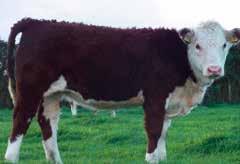
8 minute read
Herefords and dairy herd run in unison

Joseph Twose and his family milk a herd of Holsteins in west Wales in which the Hereford plays an important role.
Taking pride of place on Joseph Twose’s kitchen windowsill is a striking photograph of a Hereford heifer, evidently enjoying the attention while posing for the camera. Beca 1 Tinkerbell, a March 2020-born heifer, is gazing down the lens shortly after winning the breed championship at the 2021 Pembrokeshire County Show. “We knew she was a smart animal but we were completely blown away at winning because we were competing against some very established herds,’’ recalls Joseph, still smiling at the memory. Also working on the family’s dairy farm, Joseph bought the foundation stock for the Beca herd when he was just 20. He had recently returned to the family farm, Maenhir, at Efailwen, Pembrokeshire, after graduating with a degree in agriculture from Gelli Aur College, Carmarthenshire, joining his parents, Joe and Elinor, grandparents, Joe and Rosemary and his uncle, aunt and cousin, Richard, Jennifer and Iwan, in the day-to-day running of the business. The core enterprise is dairying, with milk produced from a herd of high yielding Holsteins, and Hereford sweeper bulls have been used on the dairy herd at Maenhir for more than 10 years. A home-bred bull, Beca 1 Smarty-Pants which is a Laertes son is currently used on the heifers, running with them after a cycle of synchronised breeding in conjunction with sexed semen. Romany 1 Romeo, purchased at a society sale at Carlisle in 2019, is turned in with the low yielding cows after 120 days. The benefits of using a Hereford are many, explains Joseph. “The Hereford is easy calving and the breed can be easily identified and so there is never any doubt that the calf is a Hereford. When you go to sell the calves, the buyers want them because of the available beef schemes,” he says.
The dairy herd calves all year round, but with a flush of heifers calving in the early autumn to provide a level supply profile for the farm’s milk buyer, First Milk. All cross-bred calves are now sold directly to private buyers from the farm at six to nine weeks, when they can command anything from £250 to £320, or more.

The aim of establishing the beef herd was to produce sweeper bulls to use on the herd, thereby enhancing biosecurity by closing the system, and to sell surplus progeny. In establishing his Beca herd, five yearling heifers were sourced from Hereford Cattle Society sales, with Joseph opting for poll lines to remove the need for dehorning as the progeny would be used on the home herd or sold to dairy farmers. “I didn’t have a massive budget to go out and buy 15 animals straight away and to spend it on animals that would be show
winners, but that wasn’t our aim. We just wanted a functional type of cow and we have done that by scaling up gradually,’’ explains Joseph, who runs the herd with support from his partner, Alice Gibson. “By breeding our own stock I have learned a lot including the type of cow that works on this farm and what I want in a cow.” Hereford sweeper bulls have been used for more than 10 years
His criteria is a medium-framed animal, easy fleshing and with plenty of milk to rear calves to 50 per cent of mature weight at weaning.
Among those foundation animals was Blackhall 1 Portia, bought for 1,600gns
which continues to reign as the herd’s top performer by producing a succession of exceptional calves. Now a six year old cow, Joseph describes this female as the backbone of the herd.
“She produces thick set calves and has tonnes of milk to rear them to weaning weight.” To make the system sustainable he calculated that he needed between 15 to 20 cows and so numbers grew, with some notable buys including Fisher 1 Eva, purchased for 4,000gns.
The herd now numbers 16 females and has the prefix Beca, a name synonymous with the Efailwen area and which has its origins in the Rebecca Riots, a series of protests undertaken by farmers and agricultural workers in west and mid Wales in response to levels of taxation.
The Hereford was Joseph’s breed of choice for multiple reasons, not least for its easy calving traits, but its ability to produce vigorous calves, and the beef price premium it attracts. He was also struck by the docility of the breed.
All breeding in the beef herd is achieved through artificial insemination because the scale doesn’t justify the economics of buying the high value bull that Joseph would want to use on the herd, he says.
AI means he can utilise genetics from selected sires, with an emphasis on calving ease and milk production. Gouldingpoll 1 Stockman is a favourite and Fabb 1 Northern Star was used on all heifers this year.
“Northern Star possesses tremendous EBVs in the areas we are focusing on, such as calving ease and short gestation, as well as being a stylish, correct bull,” says Joseph.






Maenhir Farm is home to a herd of high yielding Holsteins

“We wanted to introduce some new lines and his dam was really milky with good conformation and calving ease,’’ Joseph explains.
Gouldingpoll 1 Stockman has produced some exceptional calves for him.
“His calves are just phenomenal, thick set and of all the calves, they achieved the highest weights this year,” he says.
AI takes place in a 10 week block and Joseph brings the breeding stock in every morning to chalk their backs. “It is quite intensive for the first five weeks and then it eases off,” he says.
The herd calves in the spring with the aim of having a calving spread from the end of January to mid-April to maximise grass utilisation. This wasn’t quite achieved in 2021, with calving both starting and finishing two weeks out of synch, but Joseph is confident he will hit that target in 2022. Age at first calving is 24 months and Joseph says heifers calve down easily at that age without getting too big. “By calving at two years we are not keeping an unproductive animal for longer than we have to and in terms of performance the calves are no different to those born to a more mature cow,” says Joseph. at three months, six months and at weaning at 10 months. Weaning weight is consistently at 50 per cent of mature cow weight. The weights and other estimated breeding values (EBVs) including calving ease are recorded.
Breeding stock are sold to private buyers direct from the farm with Joseph’s biggest market for bulls being the dairy industry, but he plans to enter some into society sales in 2022. His ideal cow is one weighing 700kg while being functional and milky and producing thickset calves that perform well off grass. Registered with a high herd health scheme, the Herefords have their own block of grazing land. In the first three years, the herd was out-wintered because there wasn’t sufficient housing but a shed once used as sheep accommodation has since been renovated to make it suitable for cattle.
Utilising grass
Grazing is also a priority in the Twose family’s dairy herd and high quality silage forms the basis of the total mixed ration (TMR).
The family all have their own areas of responsibility in the dairy side of the business and for Joseph it is nutrition. “We try to utilise as much grass as we can,” says Joseph. Joseph achieves this through paddock grazing and with a system of creep fences that allow the calves to forward graze. “We have worked out a system that works for here,” he explains. “We bought some fencing posts designed for horses a couple of years ago, they are about four inches taller than standard cattle posts and this allows the calves through but not the cows.
“This system promotes growth in the calves while keeping condition down on the cows.
“We can grow grass well, it is the ground conditions that are the pinch points for us in the spring and autumn,’’ says Joseph. “We don’t “Out-wintering worked really well in the first year but winters are now definitely wetter,” says Joseph.
create smaller paddocks until April when the ground is less prone to poaching.” Creep feed isn’t introduced until six weeks prior to weaning because they receive ample nutrition for growth from milk and grass. A desire to produce high quality silage was the reason the family stopped growing wholecrop and rape and became an all-grass system. Four cuts are taken and the family do all the harvesting work themselves to give full control of quality. “It means that whenever we get a break in the weather we can go and get the best quality silage,” says Joseph. Around 161ha (400ac) is taken at both the first and second cuts, 142ha (350ac) for the third and 121ha (300ac) for the last cut of the year. The 2021 crop analysed at an average of 11.5 per cent ME, 16 per cent protein, 40 per cent dry matter and a D-value of 71.
The silage goes into the TMR with either soya or NovaPro, sugar beet, ground maize or rolled wheat and brewer’s grain. No concentrates are fed in the parlour.










